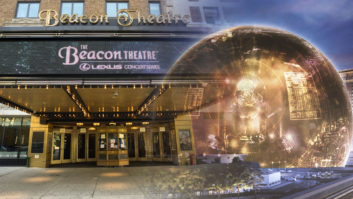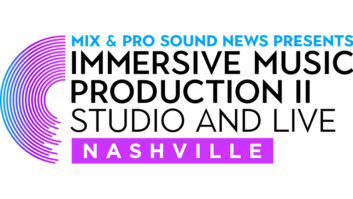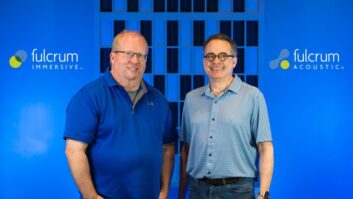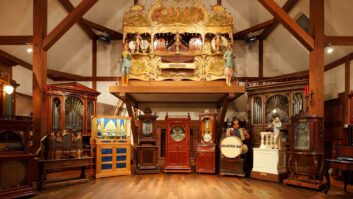Los Angeles, CA (August 1, 2018)—The audience, some dressed in pajamas, arrived carrying blankets and pillows for the world outdoor premiere of Max Richter’s Sleep in downtown Los Angeles on July 27 and 28. The composer’s “personal lullaby for a frenetic world” is an eight-hour minimalist instrumental piece intended, through an overnight performance, to accompany the sleeping mind.
Sleep was presented for the first time using d&b audiotechnik’s immersive Soundscape object-based processing, together with a large, distributed d&b loudspeaker system. “It’s an ideal way to present the work, because I’m always looking for a sense of being immersed in the sound,” says Richter. “A lot of the time, you’re telling a lie to achieve a truth. But this is very impressive in the way it manages to transmit real spaces. It’s quite magical.”
Sleep is about creating an atmosphere, says British sound designer and mixer Chris Ekers, who has known Richter for 20 years, working with him since 2004. Since its world premiere at the Kraftwerk in Berlin in 2016, the piece has always been presented indoors in naturally reverberant spaces. Consequently, says Ekers, “The idea of doing Sleep outdoors was incredibly challenging.”
The piece features Richter on piano, the five-piece American Contemporary Music Ensemble (two violins, viola, two cellos) plus soprano Grace Davidson. Richter has also developed 16 to 18 channels of playback stems of elements originally recorded for the multi-disc CD release.

“Natural sound reinforcement demands that you place the sound where the source is,” says Ekers. But as people doze off, he says, he likes to take those static images and begin to manipulate them, bringing them off the stage and enveloping the audience.
His initial draft proposal was for a d&b system with speakers at the front and rear of the audience, but as Soundscape was being publicly rolled out, Ekers took the opportunity to attend the 2018 NAMM Show and visit the site with representatives from d&b. He also consulted with Fred Vogler, principal sound designer and mixer at the Hollywood Bowl, who works with the L.A. Philharmonic and the Music Center, the presenter of the event in L.A.’s Grand Park.
“The bottom line for me was the ambient noise floor,” says Ekers. A visit to the park at midnight confirmed that it would be quiet enough.
The next challenge was how to deliver the same experience to each audience member slumbering on the 500-plus cots spread throughout the park. “Sleep is a very quiet piece. You can’t make it loud; we don’t want to take it loud. It sits there at 75 dB all night. How do you project and give everybody the impression of 75 dB over a 200-meter space?”
Ekers and Vogler drew a plan of the site on a piece of paper. “We went away with that document,” says Ekers, “and I put [the system] together in ArrayCalc,” d&b’s simulation software. “It was obvious at the start that I needed a main and delay systems. How any surrounding system within those would work, I didn’t know. They are also three very different zones.”
The stage, on a cement platform in front of a grassed area at the lower end of the park, designated Zone 1, was off-center, necessitating an asymmetrical front speaker system comprising seven flown arrays, including three across the stage, each of four d&b Y8 modules, Each was accompanied by a single J-Sub topped by a T10 for fill.
Farther up the grassy slope, two delay systems in the transition areas between Zones 1B and 2 and Zones 2 and 3 included nearly a dozen V10P arrays with additional J-Subs. Another 40 T10 speakers around the perimeter of the three zones ensured even, immersive coverage.
Zone 3 covered an upper paved area. “In many ways, the symmetry has allowed us to really use the capabilities of Soundscape extremely well; it sounds really nice up there, because we can get the loudspeakers in the right place,” says Ekers.
Audio West of Placentia, CA, supplied the sound system, Vogler reports: “It’s not like we’re putting up a few sizable arrays; we have a lot of small arrays and single boxes. Each of those requires a special clamp or yoke and special attention to how to mount and locate it. Glenn Hatch from Audio West has had as much experience and knowledge of the product as anybody. He’s also been a d&b user for several years and is a great resource.”
For any Sleep presentation, says Ekers, “My analogy is that we’re trying to build a church wherever we go. We’re trying to immerse people in that idea of being surrounded by a big, reverberant space.”
In developing the playback stems, Richter generated two channels of sends to the reverb unit he also used on the recording, TC Electronic’s System 6000. “It becomes a sonic signature of the piece,” says Ekers.
He also had d&b’s En-Space, an optional convolution reverb software tool within Soundscape, available to him. “Soundscape world allows us to go into a different domain with another layer of reverberation. The fidelity of the space that we can create now with this is quite astonishing.”
Eckers had control of object positioning via the Soundscape software on a laptop, but his DiGiCo SD10 console also featured an OSC (Open Sound Control) plug-in with controls that could be mapped as desired. “In this instance,” he says, “we decided we wanted to be able to handle the control of En-Space. The shape of the piece needs to go somewhere then come back. I wanted the opportunity to start with a particular level and then be able to adapt that, move it more into reverberation or less.”
It was Ekers’ first time hearing microphones rather than playback tracks through the Soundscape processor. “They started playing, I noodled around a bit, then we opened it up and—oh, my god—I could not believe how the separation was so extraordinary. You hit that button, En-Space kicks in—we’ve decided which hall we want to use—and suddenly we’re in it,” he says.
“In a way, this piece, performing it here, reminds me a little bit of John Cage’s 4’33”, a silent piece, performed in Times Square,” says Richter. “There’s a lot of ambient noise, things going by, traffic.
“However, there is something about music performance which builds community, I think. It’s a shared ritual; we’re going on a shared journey. And obviously the immersive feeling of the sound presentation is a big part of that.”
d&b audiotechnik • www.dbaudio.com







